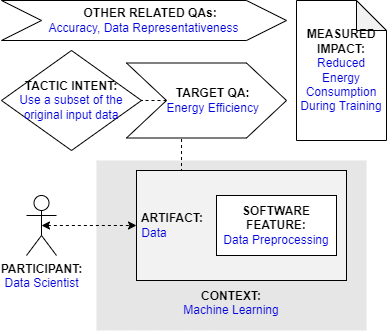All Tags
AWS
ai
algorithm-design
architecture
browser
cloud
cloud-efficiency
cloud-principles
cost-reduction
data-centric
data-compression
data-processing
deployment
design
documentation
edge-computing
email-sharing
energy-efficiency
energy-footprint
enterprise-optimization
green-ai
hardware
libraries
llm
locality
machine-learning
maintainability
management
measured
microservices
migration
mobile
model-optimization
model-training
multi-objective
network-traffic
parameter-tuning
performance
queries
rebuilding
scaling
services
storage-optimization
strategies
tabs
template
testing
workloads
Tactic: Apply Sampling Techniques
Tactic sort:
Awesome Tactic
Type: Architectural Tactic
Category: green-ml-enabled-systems
Title
Apply Sampling Techniques
Description
The size of input data has a positive correlation with the energy consumption of computing. Therefore, reducing the size of input data can have a positive impact on energy-efficiency of machine learning. Reducing input data can be done by using only a subset of the original input data. This is called sampling. There are different ways of conducting sampling (e.g., simple random sampling, systematic sampling), As an example, Verdecchia et al. (2022) used stratified sampling, which means randomly selecting data points from homogeneous subgroups of the original dataset.
Participant
Data Scientist
Related software artifact
Data
Context
Machine Learning
Software feature
Data Preprocessing
Tactic intent
Enhance energy efficiency by using a subset of the original input data for training and inference
Target quality attribute
Energy Efficiency
Other related quality attributes
Accuracy, Data Representativeness
Measured impact
Sampling can lead to savings in energy consumption during model training with only negligible reductions in accuracy. Verdecchia et al (2022) achieved decrease in energy consumption of up to 92%
Source
Verdecchia, R., Cruz, L., Sallou, J., Lin, M., Wickenden, J., & Hotellier, E. (2022, June). Data-centric green ai an exploratory empirical study. In 2022 International Conference on ICT for Sustainability (ICT4S) (pp. 35-45). IEEE.; Yue Wang, Ziyu Jiang, Xiaohan Chen, Pengfei Xu, Yang Zhao, Yingyan Lin, and Zhangyang Wang. 2019. E2-Train: Training State-of-the-art CNNs with Over 80% Energy Savings. In Advances in Neural Information Processing Systems, H. Wallach, H. Larochelle, A. Beygelzimer, F. d'Alché-Buc, E. Fox, and R. Garnett (Eds.), Vol. 32. Curran Associates, Inc. (DOI: https://doi.org/10.1109/ICT4S55073.2022.00015)Graphical representation
